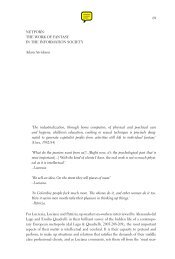Nakamura, Digitizing Race, Introduction, chapter 5, Epilogue
Nakamura, Digitizing Race, Introduction, chapter 5, Epilogue
Nakamura, Digitizing Race, Introduction, chapter 5, Epilogue
Create successful ePaper yourself
Turn your PDF publications into a flip-book with our unique Google optimized e-Paper software.
The Social Optics of <strong>Race</strong> 117<br />
what color are those bodies who will be taking care of the bodies (and<br />
houses, yards, pets, and children) of those people who are jacked in, busy<br />
scrubbing, manipulating, buying, selling, and transmitting these images?<br />
Considerations of the racialized political economies of computer culture are<br />
inseparable from the ways in which we ought to read these texts. Postmillennial<br />
science fiction texts provide us with a plethora of images of race in relation<br />
to computing and interface culture, the scene of new media image production.<br />
In this representational economy, images of blacks serve as talismans<br />
to ward off the consuming power of the interface, whose transparent depths,<br />
like Narcissus’s pool, threaten to fatally immerse its users.<br />
Minority Report (2002), directed by Steven Spielberg, also dramatizes the<br />
scene of interface use and posits whites as uniquely privileged subjects of<br />
interactivity because of their transparent and thus privileged relations to the<br />
computer. However, Minority Report dramatizes the ways that the postmillennial<br />
social body has become an object of surveillance via biometrics<br />
and crime databases. Networked digital imaging devices that perform retinal<br />
scans in public spaces like subways and department stores set in motion a<br />
web of state and commercial disciplinary mechanisms. While The Matrix is<br />
concerned with real versus unreal bodies, singular versus replicated bodies,<br />
Minority Report envisions the future regulation of the criminal body as the<br />
work of dataveillance, and the gradual interpellation of its white hero into<br />
this system’s critique and destruction as part of a process of re-racialization<br />
that calls the notion of the “whole” or singularly racialized body into question.<br />
Minority Report was released in the same year as Stephen Frears’s independent<br />
film Dirty Pretty Things, which is set in present-day London and<br />
concerns the doings of African and Turkish illegal immigrants who are<br />
involved in the world of organ harvesting and trafficking. The biotechnological<br />
revolution, part of the network economy that grew to maturity during<br />
the same period as the Internet did, has borne fruit in the world of Minority<br />
Report: human organs can be bought and sold using conventional credit cards,<br />
and there is a thriving black as well as white market in such commodities. It<br />
is when the technology of state-controlled vision extends into the organs of<br />
vision themselves that we can see the way that whiteness is also critiqued in<br />
this film, replaced with a resistant image of a transplanted, patched-together,<br />
socially marginal body that opposes itself to the dataveillant systems that<br />
demand, create, and control singular bodies. The social optics of race are<br />
hacked in this film, a film that posits a visual culture in which the act of<br />
seeing itself has become inseparable from the political economies of race,





